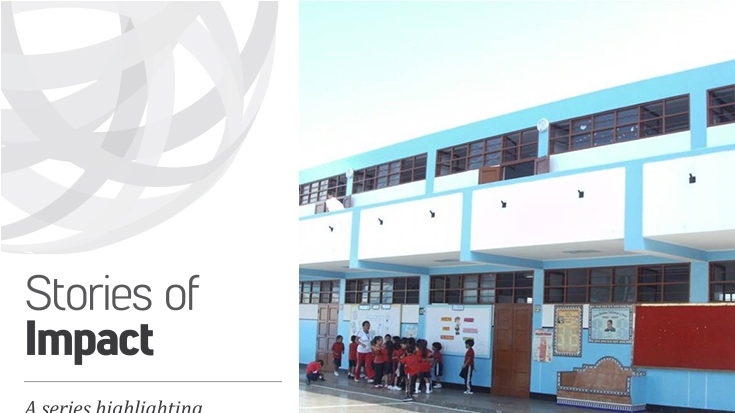REGION: LATIN AMERICA AND THE CARIBBEAN
COUNTRY: PERU
FOCUS AREA: RISK IDENTIFICATION AND RISK REDUCTION
Results & Achievements
- The Government of Peru has developed an updated national seismic hazard map and conducted a seismic risk assessment of 1,512 public schools in 48 districts in Lima and Callao.
- The Geophysical Institute of Peru and the Pontifical Catholic University of Peru were trained to conduct seismic risk assessments and can now expand and replicate this in other cities and regions in Peru.
- The Ministry of Education conducted a School Infrastructure Census of 50,000 public schools integrated with a seismic risk assessment.
- The Government of Peru is now integrating a Structural Retrofitting Program into the School Infrastructure National Plan to ensure the safety of 2 million of students nationwide.
Metropolitan Lima is subject to frequent seismic activity that can damage critical infrastructure such as schools and threaten the lives of schoolchildren. In Lima and Callao, more than 64 percent of schools are highly vulnerable to earthquakes. This leaves more than 600,000 children at risk.
To mitigate damage, protect students against the impact of earthquakes, and support their educational development the Peruvian Ministry of Education, in partnership with the World Bank and the Global Facility for Disaster Reduction and Recovery (GFDRR), is working to strengthen the structural and functional conditions of school infrastructure in the cities of Lima and Callao and reduce seismic vulnerability through a National School Infrastructure Plan and Structural Retrofitting Program.
In the Lima Metropolitan area, which has a combined population of over 9 million people, earthquakes have the ability to cause severe damage to public infrastructure. Aware of the gravity of this risk, the Government of Peru continually strives to advance its seismic risk management efforts.
As part of a long-standing collaboration, the World Bank and GFDRR have been working with the government to strengthen the country’s technical and institutional capacity in disaster risk assessment to reduce the seismic vulnerability.
Approach
Through the Probabilistic Risk Assessment (CAPRA) Program, an initiative that aims to strengthen the institutional capacity for assessing, understanding and communicating disaster risk, the World Bank and the Government of Peru have been working to promote the application of risk-related data for better informed decision making. The program applies the use of the CAPRA software, a free resource for risk analysis and decision-making.
GFDRR has supported these efforts through specific technical assistance and advisory services. Key activities included:
- Collaboration with institutions such as the Geophysical Institute of Peru to prepare national level seismic hazard maps and models.
- Tailored workshops, to train practitioners from academic institutions and government agencies to better understand risk and use the seismic modeling software (such as CAPRA) to estimate hazard, exposure and vulnerability for public schools in Lima and Callao. These studies revealed that only 8% of public school infrastructure complied with seismicresistant design codes.
- Supporting the government to incorporate this risk-related information into an intervention strategy that involves maintenance, retrofitting, and at times, relocation of schools to ensure the safety of schoolchildren.
Lessons Learned
Collaboration among institutions is essential to leverage the expertise of each stakeholder and achieve key milestones. The engagement of the Ministries of Education and Economy and Finance, the Peru Geophysical Institute and the private Pontifical Catholic University of Peru capitalized on the combined know-how of each organization, contributing towards a stronger National School Infrastructure Plan for reducing seismic vulnerability in school infrastructure.
Efficiently addressing challenges requires alignment of institutional priorities and customized technical assistance. An increased number of field visits, meetings and consistent communication between the World Bank and the Peruvian Ministry of Education helped identify issues related to lack of knowledge on potential impact of earthquakes in the schools of Lima and Callao. Understanding the local context favored the alignment of institutional priorities and the integration of technical assistance into institutional processes, such as the design of a capacity building program to assess the seismic risk of 1,512 schools. Information generated by this study is now being used to inform decision-making for disaster risk reduction in Peruvian schools.
Next Steps
To further advance the vulnerability reduction efforts in school infrastructure, the Ministry of Education will expand the process to encompass the national portfolio of schools to protect the lives and support the pedagogical development of schoolchildren. The government has announced plans to develop a National School Infrastructure Plan and a Structural Retrofitting Program which will serve as a roadmap for investments. This will require conducting a nationwide seismic risk assessment with census data to understand current school infrastructure conditions and challenges, as well as strengthening the lifecycle processes of school infrastructure.
